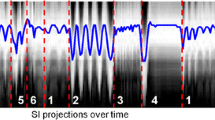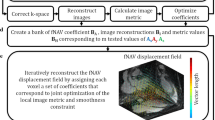Abstract
A prospective navigator algorithm with a dual acceptance window (DAW) technique was developed to reduce image artifacts induced by respiratory motion without increasing imaging time. A phantom study shows that the ghost level measured by ghost-to-image ratio was reduced by 27.1% (p < 0.005) using the DAW technique compared to the conventional single acceptance window technique. This DAW technique can also be used to reduce imaging time while maintaining comparable ghosting level.
Similar content being viewed by others
References
Li D, Paschal CB, Haacke EM, Adler LP. Coronary arteries: three-dimensional MR imaging with fat saturation and magnetization transfer contrast. Radiology 1993; 187: 401–406.
Hofman MBM, Paschal CB, Li D, Haacke EM, van Rossum AC, Sprenger M. MRI of coronary arteries: 2D breathhold vs 3D respiratory-gated acquisition. J Comput Assist Tomography 1995; 19: 56–62.
Liu YL, Riederer SJ, Rossman PJ, Grimm RC, Debbins JP, Ehman RL. Amonitoring, feedback, and triggering system for reproducible breath-hold MR imaging. Magn Reson Med 1993; 30: 507–511.
Wang Y, Grimm RC, Rossman PJ, Debbins JP, Riederer SJ, Ehman RL. 3D coronary MR angiography in multiple breath-holds using a respiratory feedback monitor. Magn Reson Med 1995; 34: 11–16.
Wang Y, Rossman PJ, Grimm RC, Riederer SJ, Ehman RL. Navigator-echo-based real-time respiratory gating and triggering for reduction of respiratory effects in three-dimensional coronary MR angiography. Radiology 1996; 198: 55–60.
Li D, Kaushikkar S, Haacke EM, et al. Coronary arteries: three-dimensional MR imaging with retrospective respiratory gating. Radiology 1996; 201: 857–863.
Danias PG, McConnell MV, Khasgiwala VC, Chung ML, Edelman RR, Manning WJ. Prospective navigator correction of image position for coronary MR angiography. Radiology 1997; 203: 733–736.
Wang Y, Riederer SJ, Ehman RL. Respiratory motion of the heart: kinematics and the implications for the spatial resolution in coronary imaging. Magn Reson Med 1995; 33: 713–719.
Taylor AM, Jhooti P, Wiesmann F, Keegan J, Firmin DN, Pennell DJ. MR navigator-echo monitoring of temporal changes in diaphragm position: implications for MR coronary angiography. J Magn Reson Imaging 1997; 7: 629–636.
Sachs TS, Meyer CH, Irarrazabal P, Hu BS, Nishimura DG, Macovski A. The diminishing variance algorithm for real-time reduction of motion artifacts in MRI. Magn Reson Med 1995; 34: 412–422.
Du YP, McVeigh ER, Bluemke DA, Silber HA, Foo TKF. Acomparison of prospective and retrospective respiratory navigator gating in 3D MR coronary angiography. Int J Card Imaging 2001; 17: 287–294.
Weiger M, Bornert P, Proksa R, Schaffter T, Haase A. Motion-adapted gating based on k-space weighting for reduction of respiratory motion artifacts. Magn Reson Med 1997; 38: 322–333.
Sinkus R, Bornert P. Motion pattern adapted real-time respiratory gating. Magn Reson Med 2000; 41: 148–155.
Jhooti P, Keegan J, Gatehouse PD, et al. 3D coronary artery imaging with phase reordering for improved scan efficiency. Magn Reson Med 1999; 41: 555–562.
Jhooti P, Gatehouse PD, Keegan J, Bunce NH, Taylor AM, Firmin DN. Phase ordering with automatic window selection (PAWS): a novel motion-resistant technique for 3D coronary imaging. Magn Reson Med 2000; 43: 470–480.
Fuderer M. The information content of MR images. IEEE Trans Med Imaging 1988; 7: 368–380.
Jhooti P, Wiesmann F, Taylor AM, et al. Hybrid ordered phase encoding (HOPE): an improved approach for respiratory artifact reduction. J Magn Reson Imaging 1998; 8: 968–980.
Du YP, Saranathan M, Foo TKF. A computationally efficient algorithm for accurate detection of diaphragm displacement in navigated 3D coronary MR angiography. Proceedings of the Eighth Scientific Meeting of ISMRM. Denver, 2000; 1624.
Author information
Authors and Affiliations
Rights and permissions
About this article
Cite this article
Du, Y.P. Prospective navigator gating with a dual acceptance window technique to reduce respiratory motion artifacts in 3D MR coronary angiography. Int J Cardiovasc Imaging 19, 157–162 (2003). https://doi.org/10.1023/A:1022829900393
Issue Date:
DOI: https://doi.org/10.1023/A:1022829900393




